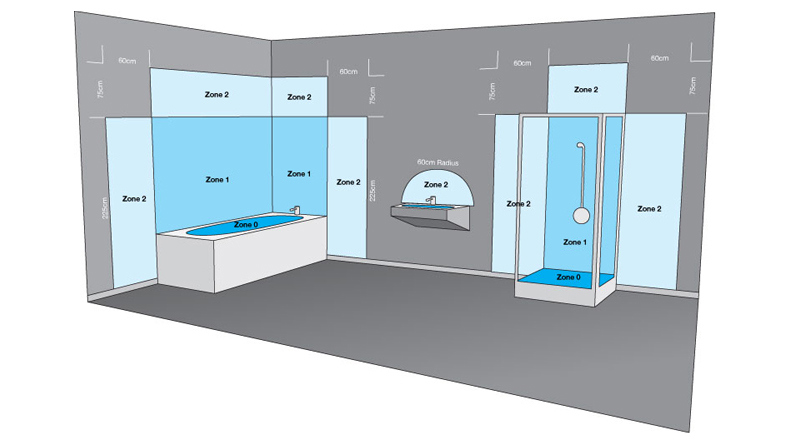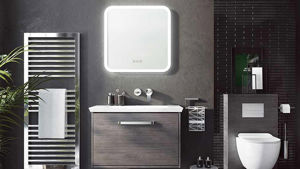Smart bathrooms with advanced bathroom technology are becoming more popular, and more electrical appliances are being installed in Britain’s bathrooms.
When decorating or installing a bathroom, one of the things that need consideration is the positioning of these electrical items in relation to your bath or shower. These are called 'electrical zones'.
Ready to consider some bathroom lighting ideas?
Minimising Risks
Bathrooms are considered to be a ‘special location’ for electrical goods, and special care and attention need to be taken when placing them in a room. This is due to the increased risk of electrical shock caused by close proximity of electrical appliances to water within a bathroom.
Examples of electrical appliances and fittings within a bathroom are lighting, ventilation, bathroom radiators, illuminated mirrors and cabinets. It’s important that any of these appliances are placed in their designated bathroom electrical zone to eliminate any threat that they could potentially cause.

There are 3 bathroom electrical zones that have been identified in the IEE wiring regulations and these are:
Zone 0
Zone 0 is quite basically, anywhere inside a bath, basin or shower itself. It’s defined as ‘any area within a bathroom that can hold water’. Any fitting or appliance used within zone 0 must be a maximum of 12 volts (SELV) and fully protected against both partial and total immersion in water (minimum rating of IPX7).
Zone 1
Zone 1 in simple terms, is often labelled as the ‘splash zone,’ where installed equipment is likely to get wet but would not necessarily be submerged. The area directly above zone 0 to the height of 2.25m from the bottom of the bath or shower is zone 1. It also covers the width of the shower cubicle or the length of the bath. Any fitting or appliance within zone 1 must be IPX4 (splashproof) or better, as well as a maximum of 12 volts (SELV) with the transformer located beyond zone 2.
Remember, zone 1 does not include zone 0.
Zone 2
Zone 2 is the area stretching to 600mm outside of the bath or shower, be that above or to the sides of each. This is typically the area that is least likely to get wet but there is a possibility for it to be splashed. Any fitting or appliance within zone 2 must be IPX4 (splashproof) or better, as well as a maximum of 12 volts (SELV) with the transformer located beyond zone 2.
Outside Zones (Beyond Zone 2)
When the size of a bathroom extends beyond zones 0, 1 and 2, portable equipment can be used if its flex length does not enable it to be used in zone 2. For instance, a hairdryer can be installed in the outside zones as long as its stretched length does not allow it to be used in zone 2. Although installing electrical equipment beyond zone 2 is permitted without an IP number, it is always encouraged that electrical items have some sort of mechanical and moisture protection.
IP Ratings Explained
As seen here, electrical equipment may be identified as having a given level of mechanical and moisture protection. These are, more often than not, denoted as ‘ingress protection’ or ‘IP’ numbers. The ‘IP’ notation is followed by two digits that indicate a numerical level of mechanical and moisture protection. The higher the number, the better protection it has against moisture or breakage. If a piece of equipment does not have an IP number, it should not be used in zones 0, 1, 2 or anywhere that has a damp environment.

Check out our guide to heating in the bathroom next
Useful Terms
All electrical circuits within a bathroom must be protected by a residual current device (RCD), sometimes known as a circuit breaker, not exceeding 30mA. RCDs detect when an electric current is not balanced or functioning correctly, and stops the flow of electricity if necessary to ensure safety.
SELV stands for ‘safety extra low voltage.’ This is used in situations where the electrical equipment presents a serious hazard, for example, in bathrooms and swimming pools. Live conductors at SELV must be electrically separated from the earth.
PELV stands for ‘protection by extra low voltage.’ This system is used for general use where low voltage is required as it is not deemed to be a high-risk location. The PELV system is not electrically separated from earth.
Installing any electrics in the bathroom can be a complex and dangerous task. Always use a registered bathroom fitter or electrician. If you’re unsure of the correct location to install an electrical fitting or appliance in your bathroom, feel free to contact us at hello@drench.co.uk or speak to us on our live chat.
*The information on this page is for guidance only and is correct at the time of publishing. Always refer to the current IEE regulations of a qualified fitter or electrician to ensure that you are within the latest regulations and codes of practice.






